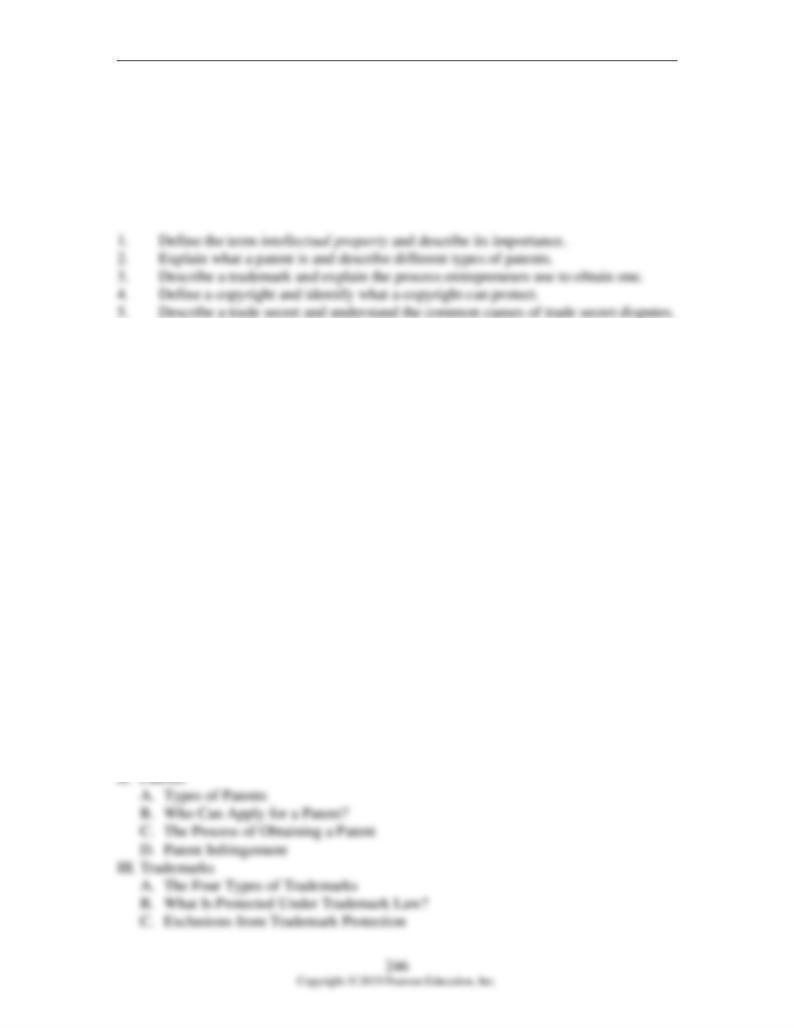
Chapter 12: The Importance of Intellectual Property
CHAPTER 12
THE IMPORTANCE OF INTELLECTUAL PROPERTY
LEARNING OBJECTIVES
6.
Explain what an intellectual property audit is and identify the two primary reasons
entrepreneurial firms should complete this type of audit.
CHAPTER OVERVIEW
This chapter focuses on the important topic of intellectual property. The chapter begins
by talking about the importance of intellectual property, and discusses how to determine
which intellectual property to legally protect. The four key forms of intellectual property
are then introduced, including patents, trademarks, copyright, and trade secrets.
The middle portion of the chapter focuses on patents, trademarks, copyrights, and trade
secrets. A complete description of each of these forms of intellectual property is
described, including how to obtain legal protection in each of these areas.
The chapter ends with a discussion of how to complete an intellectual property audit. It is
important that a firm have a full awareness of the intellectual property that it owns, to
make sure it is properly protected and to be able to justify its valuation in the event of an
acquisition or merger.
CHAPTER OUTLINE
I. The Importance of Intellectual Property
A. Determining What Intellectual Property to Legally Protect
B. The Four Key Forms of Intellectual Property
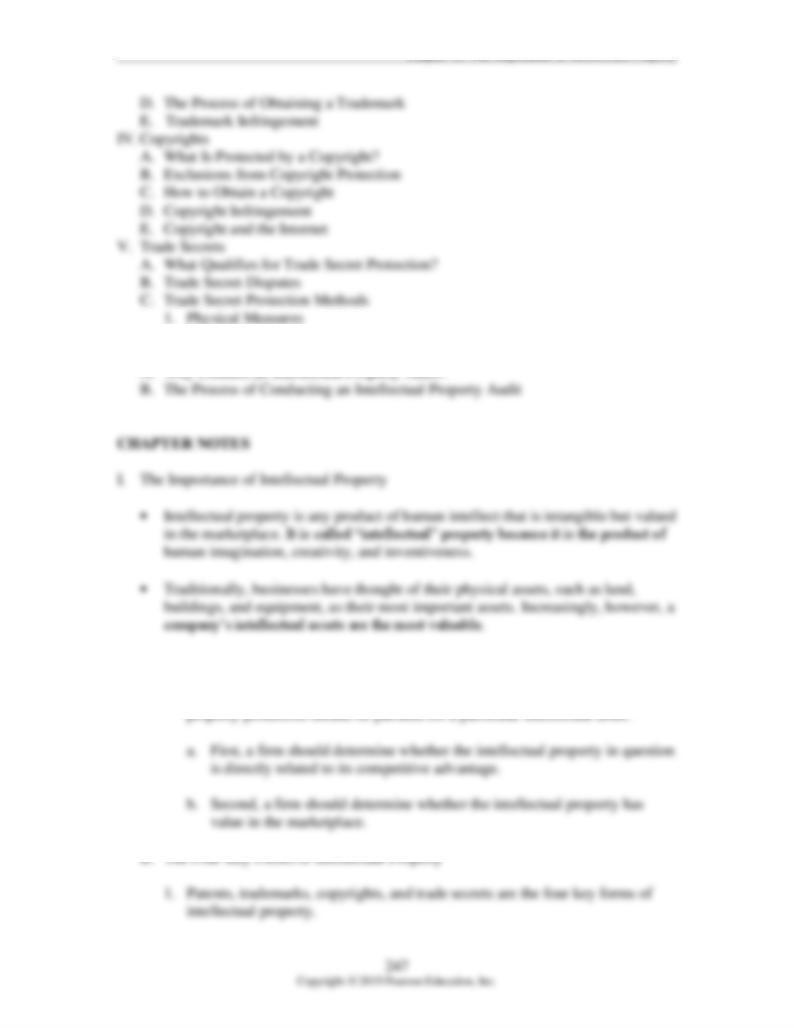
Chapter 12: The Importance of Intellectual Property
2. Written Agreements
VI. Conducting an Intellectual Property Audit
1. There are two primary rules of thumb for determining whether intellectual
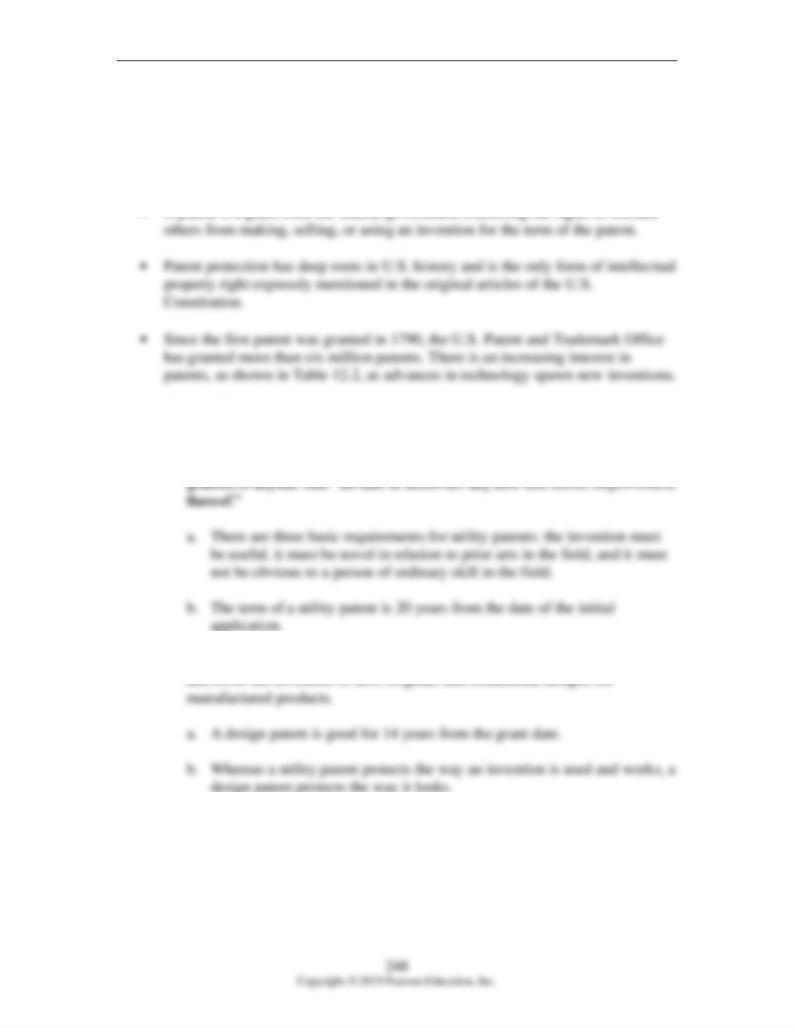
Chapter 12: The Importance of Intellectual Property
2. Intellectual property laws exist to encourage creativity and innovation by
granting to individuals who risk their time and money in creative endeavors
exclusive rights to the fruits of their labor for a period of time.
II. Patents
1. Utility Patents. Utility patents are the most common type of patent and cover
what we generally think of as new inventions. Patents in this category may be
2. Design Patents. Design patents are the second most common type of patent
3. Plant Patents. Plant patents protect new varieties of plants that can be
reproduced asexually. Such plants are reproduced by grafting or crossbreeding
rather than by planting seeds.
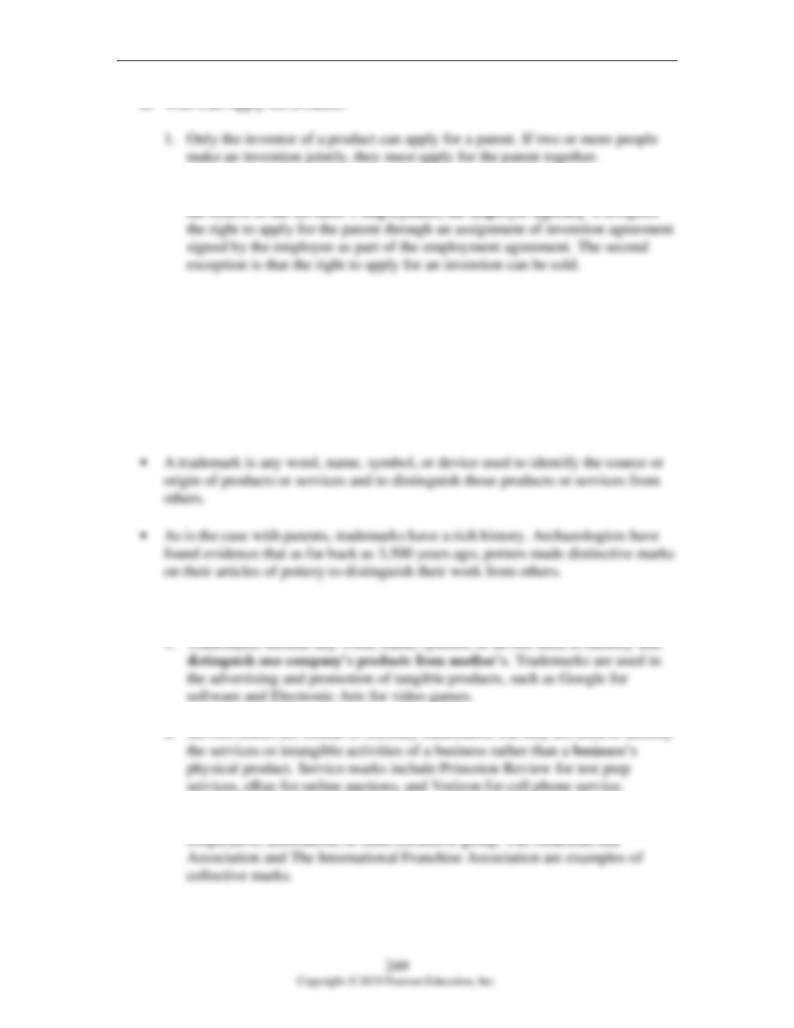
Chapter 12: The Importance of Intellectual Property
2. There are notable exceptions to this rule. First, if an invention is made during
1. Obtaining a patent is a six-step process, as illustrated in Figure 12.3 in the
textbook.
D. Patent Infringement
III. Trademarks
1. Trademarks include any word, name, symbol, or device used to identify and
3. Collective marks are trademarks or service marks used by the members of a
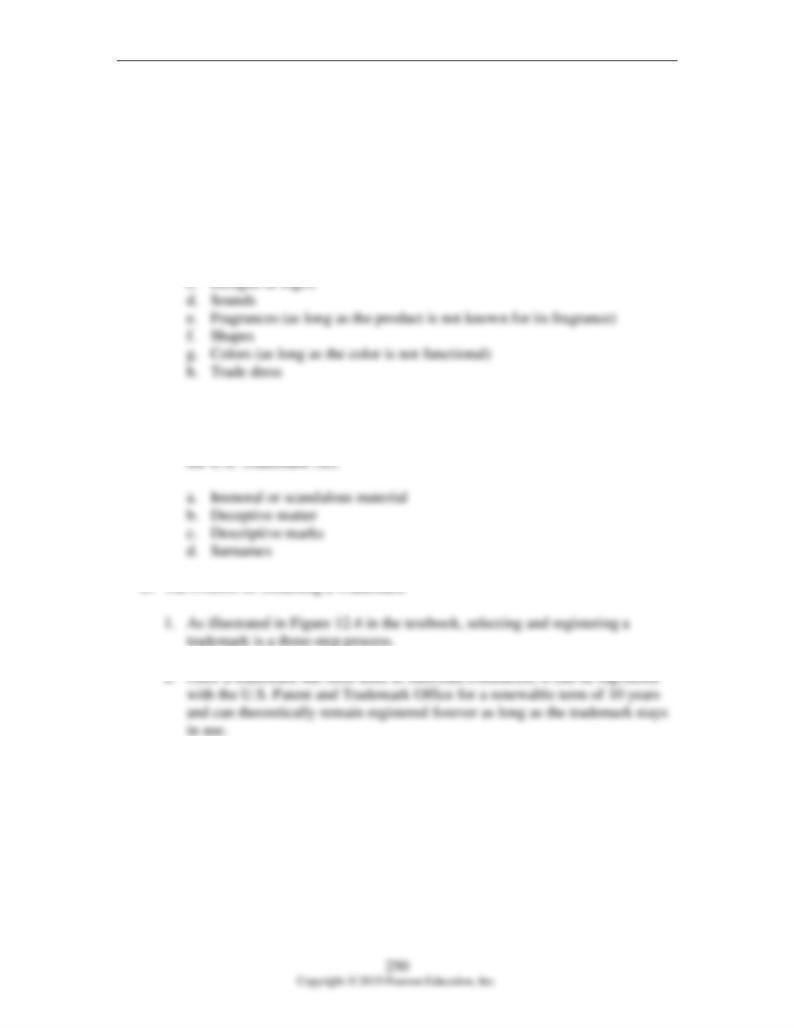
Chapter 12: The Importance of Intellectual Property
4. Certification marks are marks, words, names, symbols, or devices used by a
person other than its owner to certify a particular quality about a product or
service. An example is the Good Housekeeping Seal of Approval.
B. What Is Protected Under Trademark Law?
1. Trademark law protects the following items:
a. Words
b. Numbers and letters
1. There are notable exclusions from trademark protection that are set forth in
3. There are three steps in selecting and registering a trademark:
a. Select an appropriate mark.
b. Perform a trademark search.
c. Create rights in the trademark.
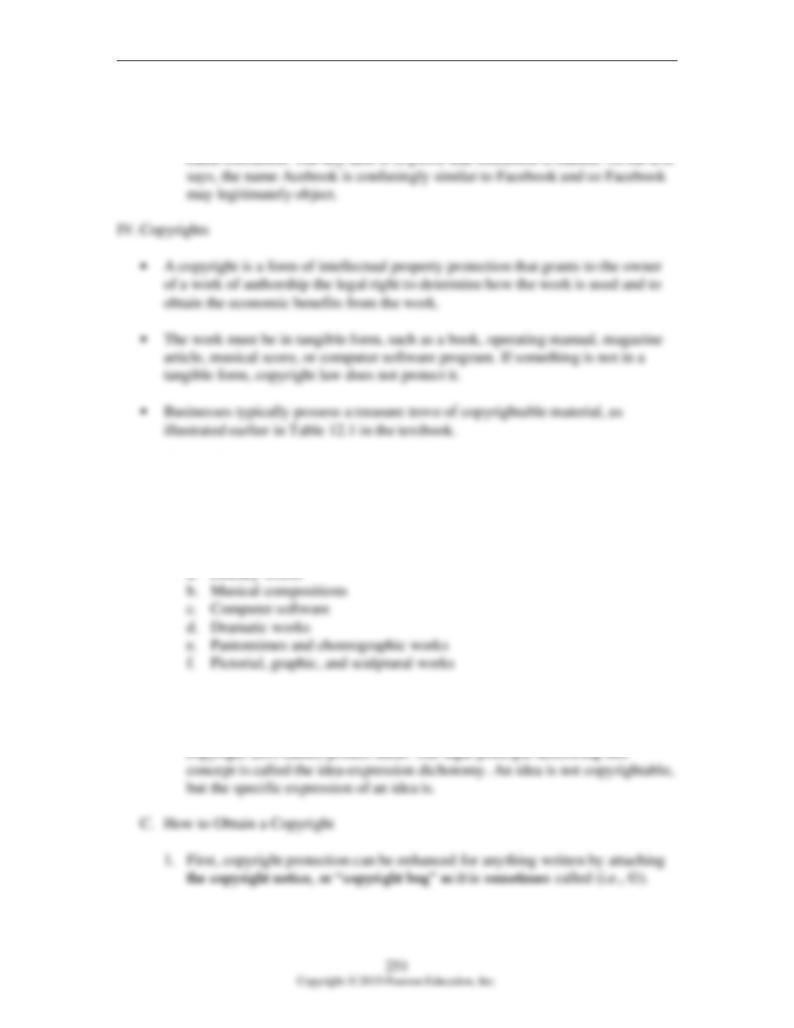
Chapter 12: The Importance of Intellectual Property
E. Trademark Infringement
• A trademark is infringed when an unauthorized use is done in a manner to
1. Copyright laws protect “original works of authorship” that are fixed in a
tangible form of expression. The primary categories of material that can be
copyrighted follow:
a. Literary works
1. There are exclusions from copyright protection. The main exclusion is that
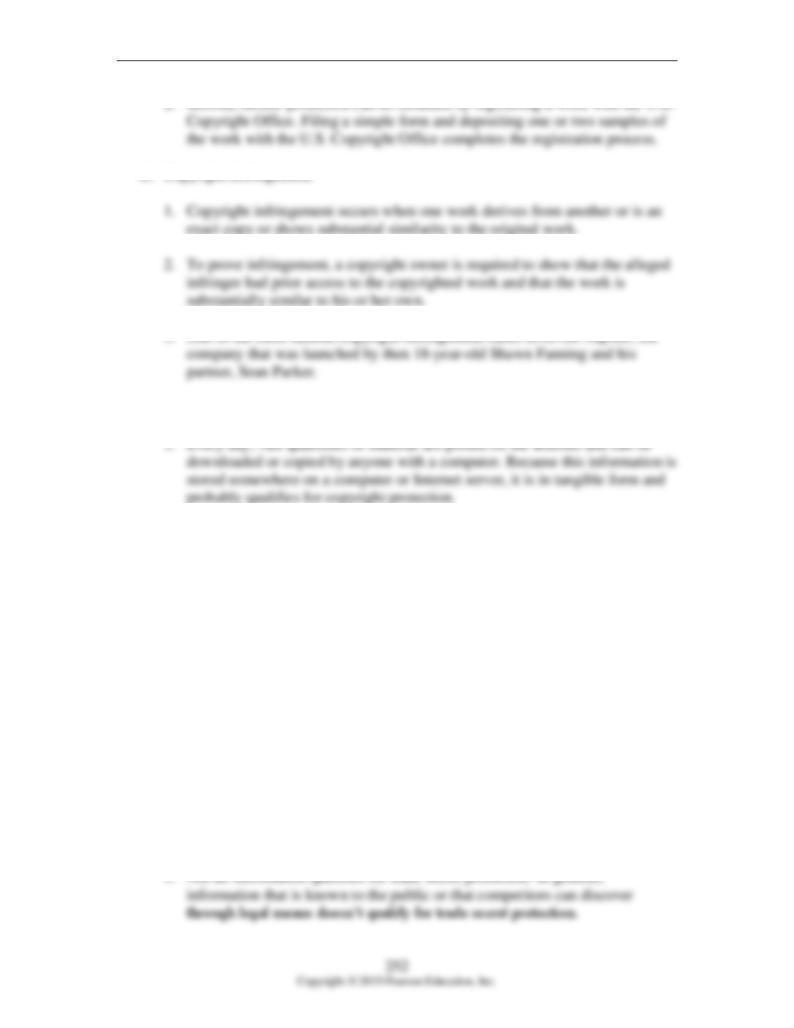
Chapter 12: The Importance of Intellectual Property
3. One of the most famous copyright infringement cases involved Napster, the
1. Every day, vast quantities of material are posted on the Internet and can be
2. Copyright laws, particularly as they apply to the Internet, are sometimes
difficult to follow, and it is easy for people to dismiss them as contrary to
common sense. Still, entrepreneurs should guard themselves against taking
too lax of an attitude regarding copyright laws and the Internet.
V. Trade Secrets
• A trade secret is any formula, pattern, physical device, idea, process, or other
information that provides the owner of the information with a competitive
advantage in the marketplace.
• Trade secrets include marketing plans, product formulas, financial forecasts,
employee rosters, and logs of sales calls.
• The Federal Economic Espionage Act, passed in 1996, criminalizes the theft of
trade secrets.
A. What Qualifies for Trade Secret Protection?
1. Not all information qualifies for trade secret protection. In general,
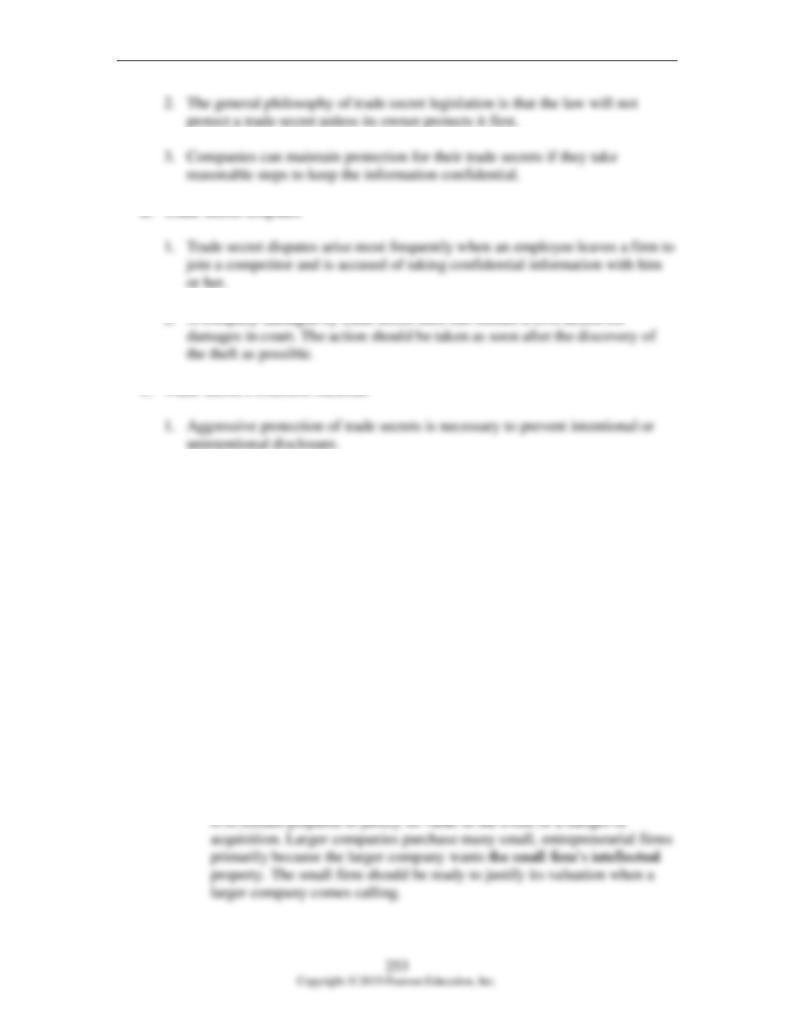
Chapter 12: The Importance of Intellectual Property
2. A company damaged by trade secret theft can initiate a civil action for
2. In addition, one of the key factors in determining whether something
constitutes a trade secret is the extent of the efforts to keep it secret.
Companies protect trade secrets through physical measures and written
agreements.
VI. Conducting an Intellectual Property Audit
• The first step a firm should take to protect its intellectual property is to complete
an intellectual property audit. An intellectual property audit is completed to
determine the intellectual property a company owns.
A. Why Conduct an Intellectual Property Audit?
1. There are two primary reasons for conducting an intellectual property audit.
a. First, it is prudent for a company to periodically determine whether its
intellectual property is being properly protected.
b. The second reason for a company to conduct an intellectual property audit

Chapter 12: The Importance of Intellectual Property
2. The second step is to identify works in progress to ensure that they are being
documented in a systematic, orderly manner.
BOXED FEATURES: QUESTIONS FOR CRITICAL THINKING
1.
What is your reaction to each case? Were you surprised at how they turned out?
Do you think each case turned out the way the trademark law intended it to?
2.
Which of the three smaller companies profiled – Eat More Kale, Xoom, or Snacks
5th Avenchew – do you think had the strongest case in defending the name it was
using? Which company do you think had the weakest case?
3.
Why do you think Bo Muller-Moore was able to elicit such passion and support in
his trademark dispute with Chick-fil-A?
4.
To what degree do you think these cases should embolden small firms so they
won’t always have to give in to larger firms in intellectual property disputes if they
think the law is on their side?
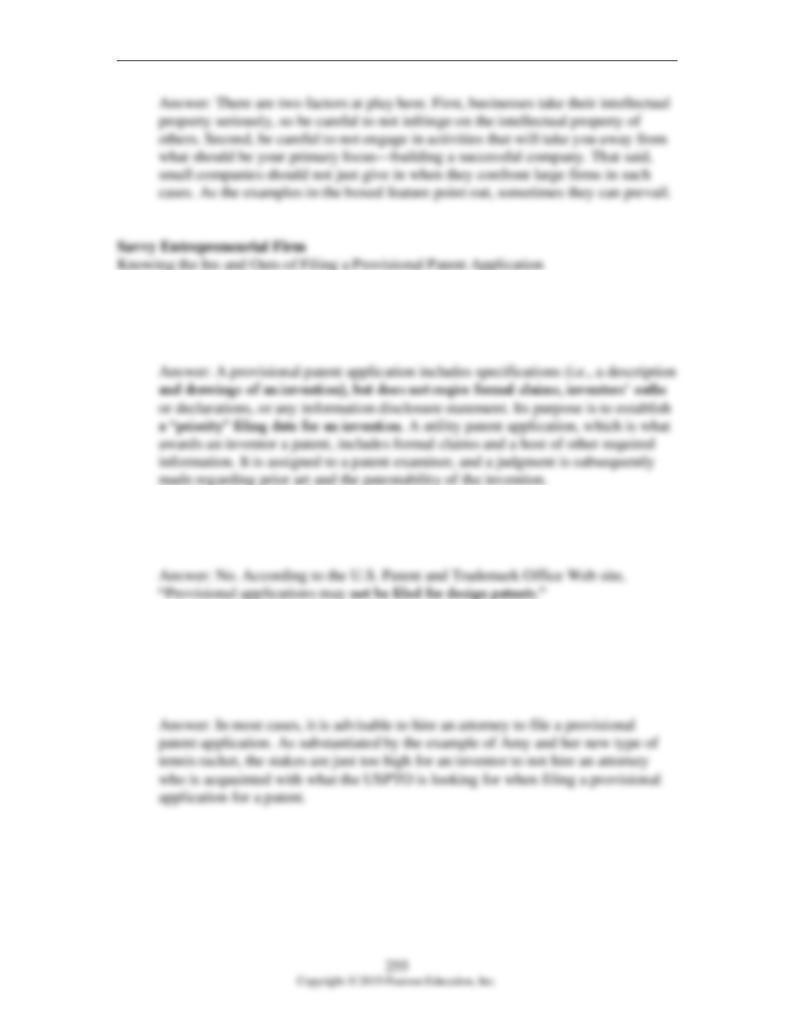
Chapter 12: The Importance of Intellectual Property
1.
Briefly describe the difference between a provisional patent application and a
utility patent application. If successful, which of the two applications awards an
inventor a patent?
2.
Can a provisional patent application be filed for a design patent? Document your
research to arrive at the correct answer to this question.
3.
Under what circumstances would you (1) suggest to an inventor that he or she
could file a provisional patent application without a patent attorney or (2) suggest
to an inventor that he or she needs to hire a patent attorney to file the provisional
patent application?

Chapter 12: The Importance of Intellectual Property
4.
Spend some time studying the USPTO official Web site, or do some Internet
research on patents. Inventor’s Digest (www.inventorsdigest.com) is another good
resource for learning about patents. Discuss one fact about patents or the
application process you find interesting and isn’t included in the material in this
chapter.
1.
Identify the makerspace, FabLab, or TechShop that is located nearest you.
Describe the equipment that is available and the program the facility offers.
2.
Why do you think companies are increasingly open to ideas from independent
inventors?
3.
Find an idea submission site for a company not mentioned in the feature. Describe
how to submit an invention to the company. What appear to be the keys to getting
an idea accepted by the company?
4.
In most cases, do you think inventors and entrepreneurs get a fair shake when they
sell or license a product to a large company? What steps should entrepreneurs take
to make sure they are getting a fair deal?
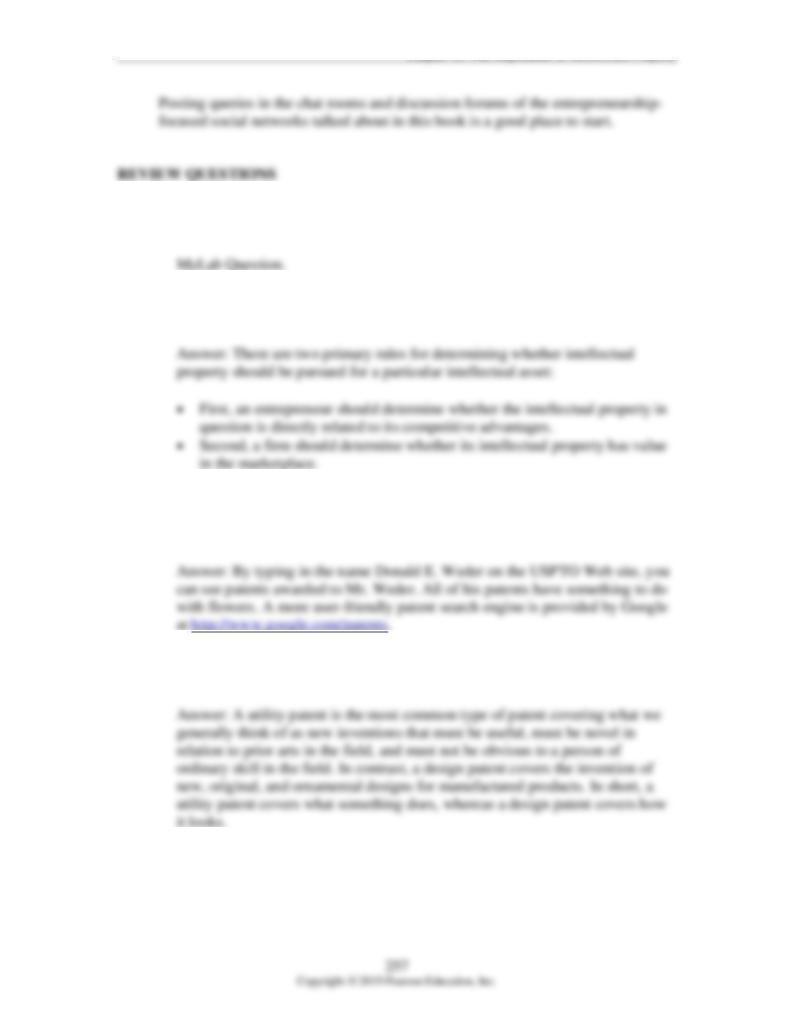
Chapter 12: The Importance of Intellectual Property
12-1.
What distinguishes intellectual property from other types of property, such as
land, buildings, and inventory?
12-2.
What are the two primary rules for determining whether intellectual property
protection should be pursued for a particular intellectual asset?
12-3.
Search the USPTO database and find three patents issued to Donald E. Weder
of Highland Park, Illinois. Describe the patents. In what areas are most of Mr.
Weder’s patents?
12-4.
What are the major differences between utility patents and design patents?
Provide an example of each.
12-5.
What is a business method patent? Provide an example of a business method
patent. How can having such a patent provide a firm a competitive advantage in
the marketplace?
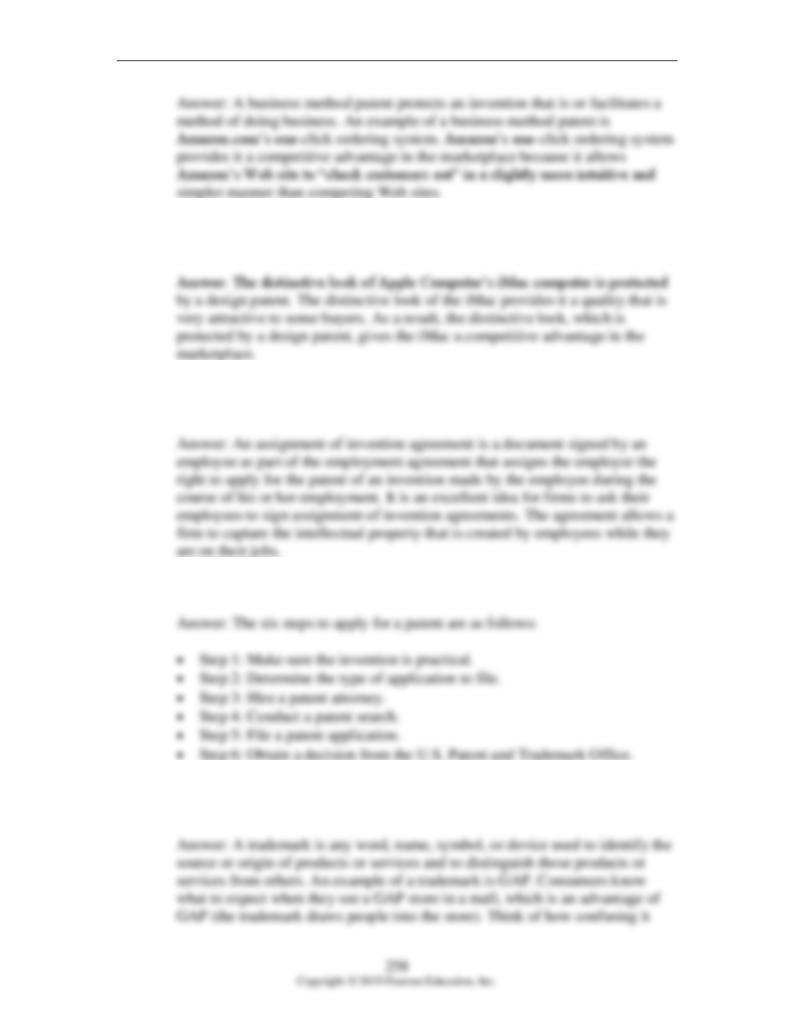
Chapter 12: The Importance of Intellectual Property
12-6.
Give an example of a design patent. How can having a design patent provide a
firm a competitive advantage in the marketplace?
12-7.
What is the purpose of an assignment of invention agreement? Is it a good idea
for firms to ask their employees to sign assignment of invention agreements?
12-8.
What are the six steps in applying for a patent?
12-9.
What is a trademark? How can a trademark help a firm establish a competitive
advantage in the marketplace?
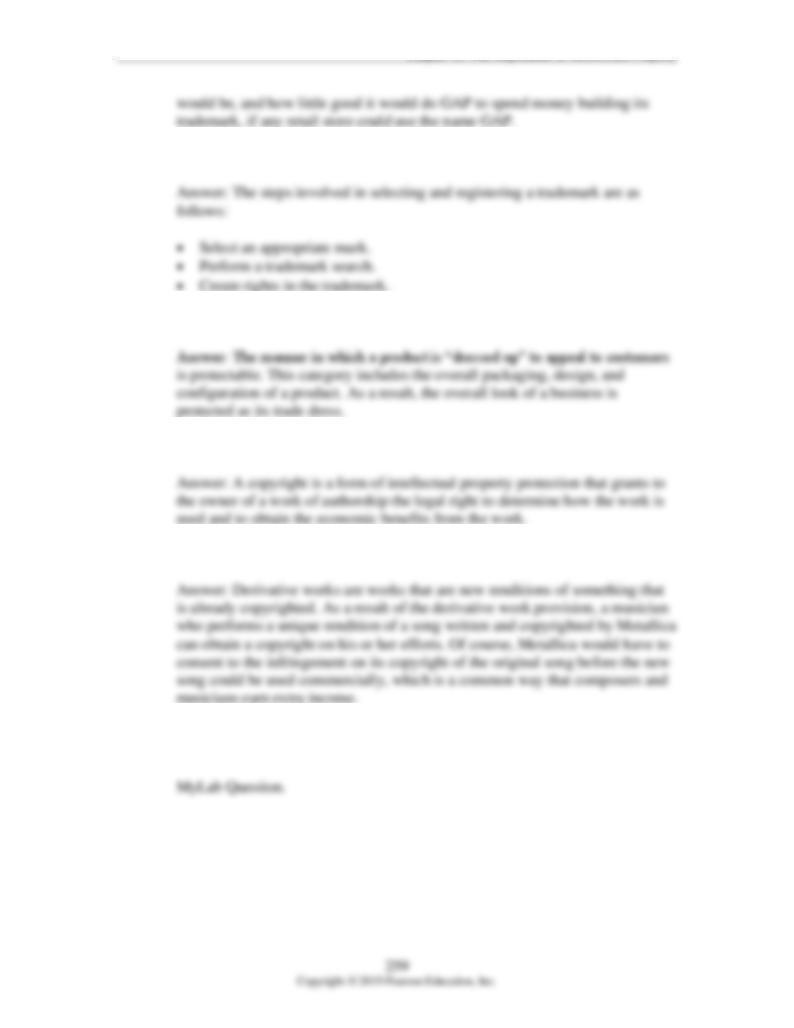
Chapter 12: The Importance of Intellectual Property
12-10.
What are the three steps involved in selecting and registering a trademark?
12-11.
What is meant by the term trade dress?
12-12.
What is a copyright?
12-13.
In the context of copyright law, what is meant by the term derivative work?
12-14.
If an entrepreneur has an idea for a themed restaurant based on television game
shows, is the idea itself eligible for copyright protection? Why or why not?
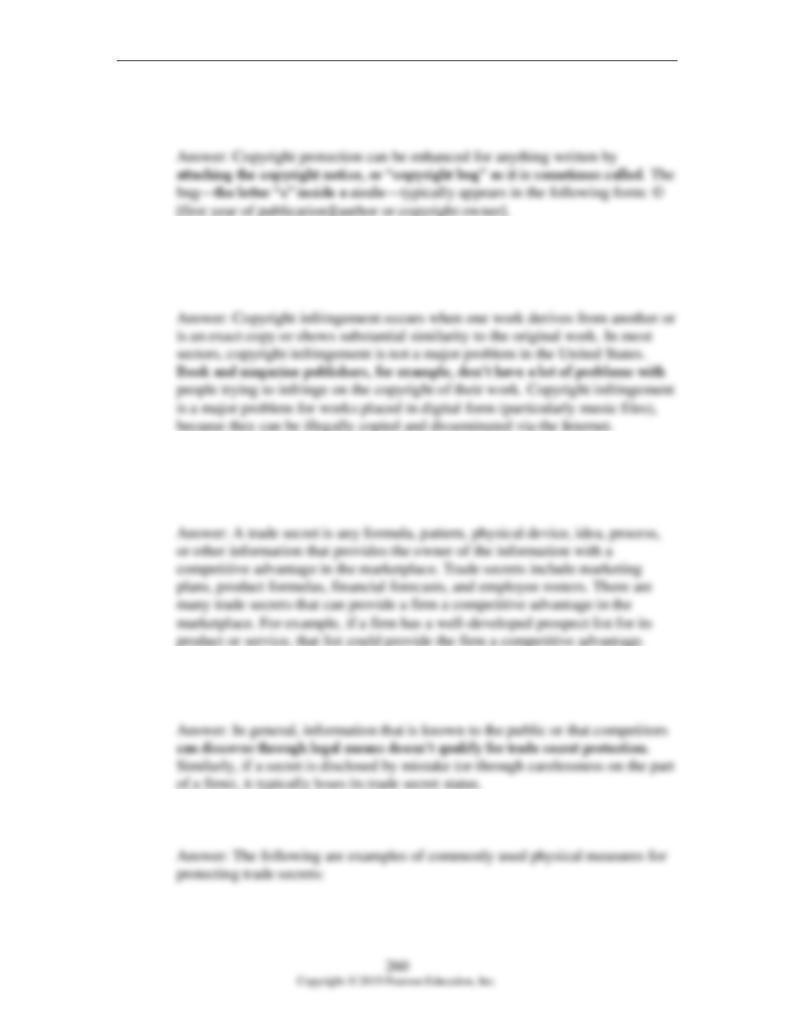
Chapter 12: The Importance of Intellectual Property
12-15.
What is a copyright bug? Where would one expect to find the bug, and how is it
used?
12-16.
What is meant by the phrase copyright infringement? Would you characterize
copyright infringement as a minor or as a major problem in the United States
and in other countries? Explain.
12-17.
What is a trade secret? Provide an example of a trade secret. How might the
trade secret you identified help a firm establish a competitive advantage in the
marketplace?
12-18.
What information does not qualify for trade secret protection? Make your
answer as thorough as possible.
12-19.
What types of physical measures do firms take to protect their trade secrets?
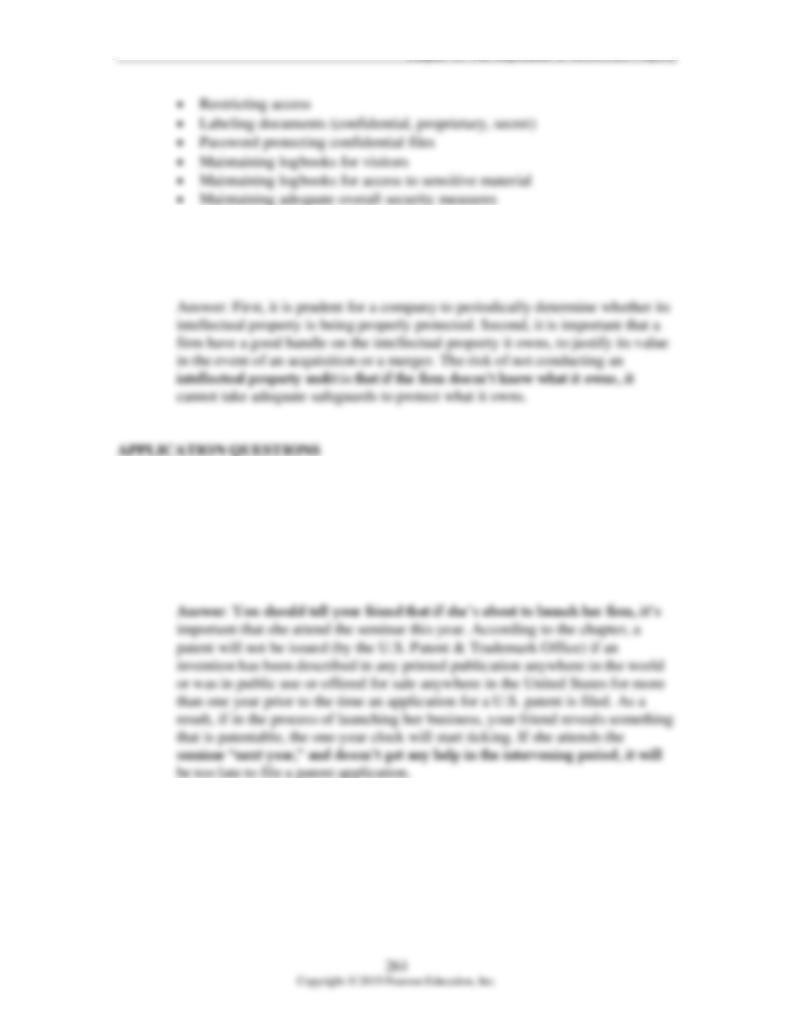
Chapter 12: The Importance of Intellectual Property
12-20.
What are the two primary purposes of conducting an intellectual property audit?
What risks does a company run if it doesn’t periodically conduct an intellectual
property audit?
12-21.
Imagine you are about to attend a one-day seminar dealing with intellectual
property law, and you contact a friend of yours who is in the process of starting
a business to urge her to attend the seminar with you. She says to you, “I’m
really busy because I’m just about to launch my start-up, so I’ll have to pass. If
they offer the same seminar next year, I’ll go with you then.” How would you
respond to your friend?
12-22.
Access the USPTO Web site and look up U.S. Patent Number 5,433,036.
Describe the purpose of the patent. Do you think this patent describes an
invention that has commercial potential? On a scale of 1 to 10 (10 is high), how
significant do you think the potential is?
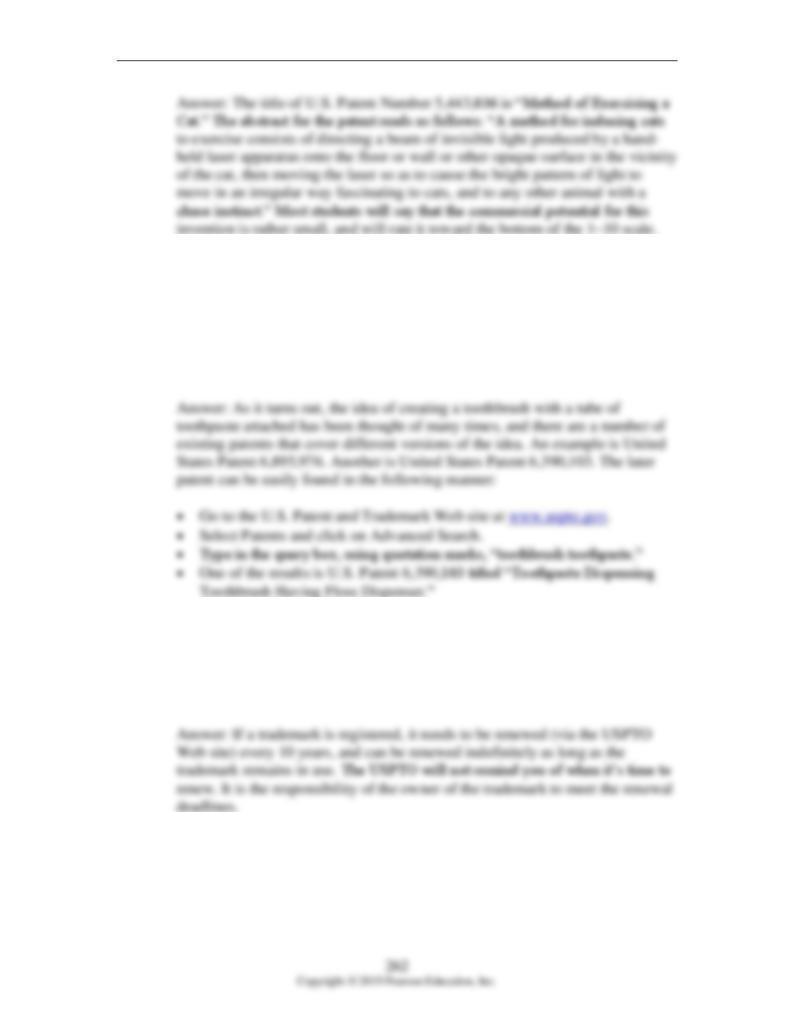
Chapter 12: The Importance of Intellectual Property
12-23.
Tyler Simms just invented a new product that he is convinced is unique and will
make him wealthy. The product is a toothbrush with a tube of toothpaste
attached to the handle. Tyler is anxious to file a patent application on the
product, but when he tells you about the idea, you say—“Whoa, let’s do a
preliminary patent application search first to see if someone else has already
patented this idea.” What do you find when you help Tyler with the preliminary
search?
12-24.
According to the chapter, a trademark registered with the USPTO can
theoretically remain registered forever as long as it stays in use. Does the owner
of a trademark have to take affirmative action to demonstrate to the USPTO
office that a trademark is remaining in use? If so, what is the process that must
be followed?
12-25.
Pam Tarver just opened an information technology consulting company and has
thought for a long time about what to name it. She finally settled on the
fictitious name Infoxx. Search the USPTO database to determine if the name
Infoxx is available. Is it? If it is available, describe how Pam would go about
obtaining a trademark on Infoxx or any other name.
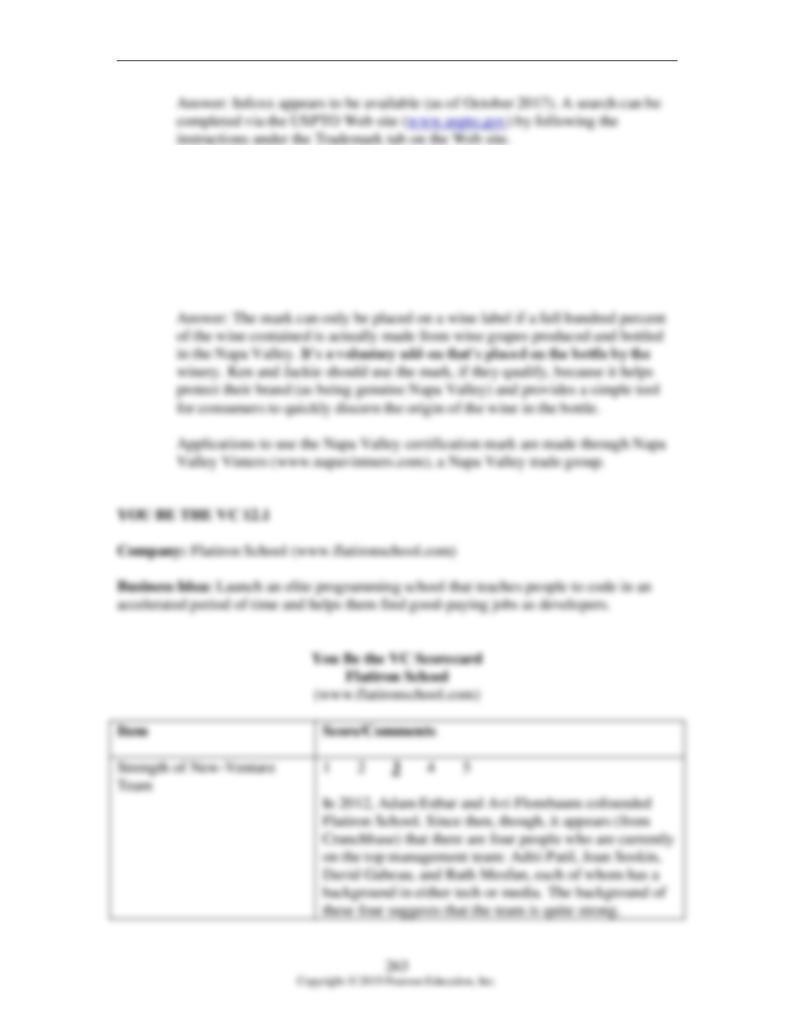
Chapter 12: The Importance of Intellectual Property
12-26.
Ken and Jackie Smith just purchased a small winery in the Napa Valley of
northern California. One thing they noticed when they were investigating the
winery is that the owners never placed the “100% Napa Valley” certification
mark on their bottles. Now that they own the winery Ken and Jackie are looking
into using the mark. Investigate what is required to place the “100% Napa
Valley” certification mark on a bottle of wine. If Ken and Jackie’s winery
qualifies, should they use the mark?
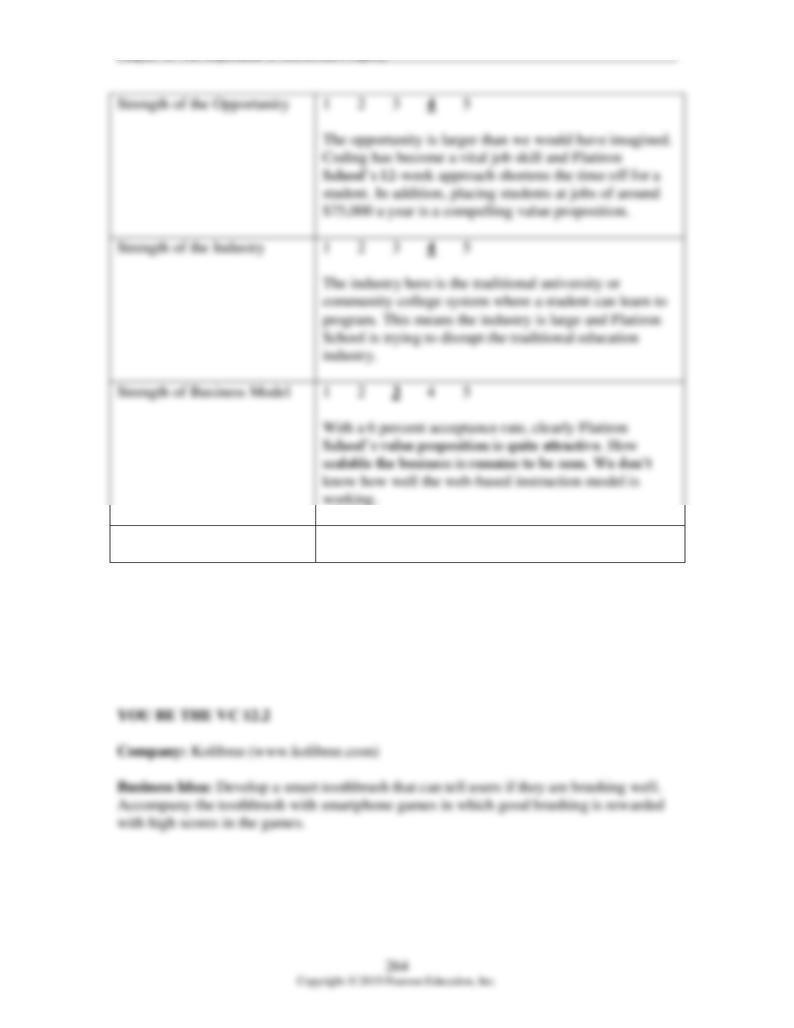
Chapter 12: The Importance of Intellectual Property
Average Score
3.5/5.0
Decision: While Flatiron School has a compelling value proposition and a great
opportunity, we would not fund it because we are not quite sure if they have a scalable
model. It is one thing to offer intensive coding classes to an arguably small group of
students in one location, but we don’t know how well this can be scaled up or replicated.
Also, if they do scale up, can they continue to offer placement to their graduates?
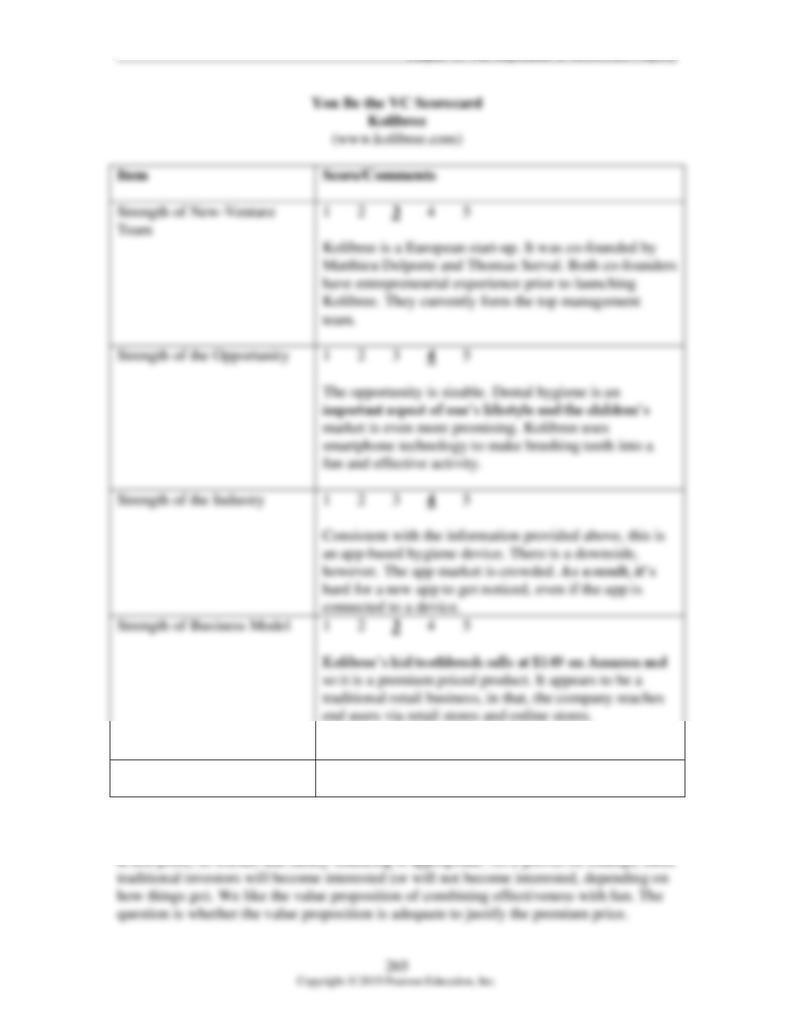
Chapter 12: The Importance of Intellectual Property
Average Score
3.5/5.0
Decision: We would not fund Kolibree at this time, but are interested in following the
firm and may become interested in offering funding at a later date. Kolibree is unproven
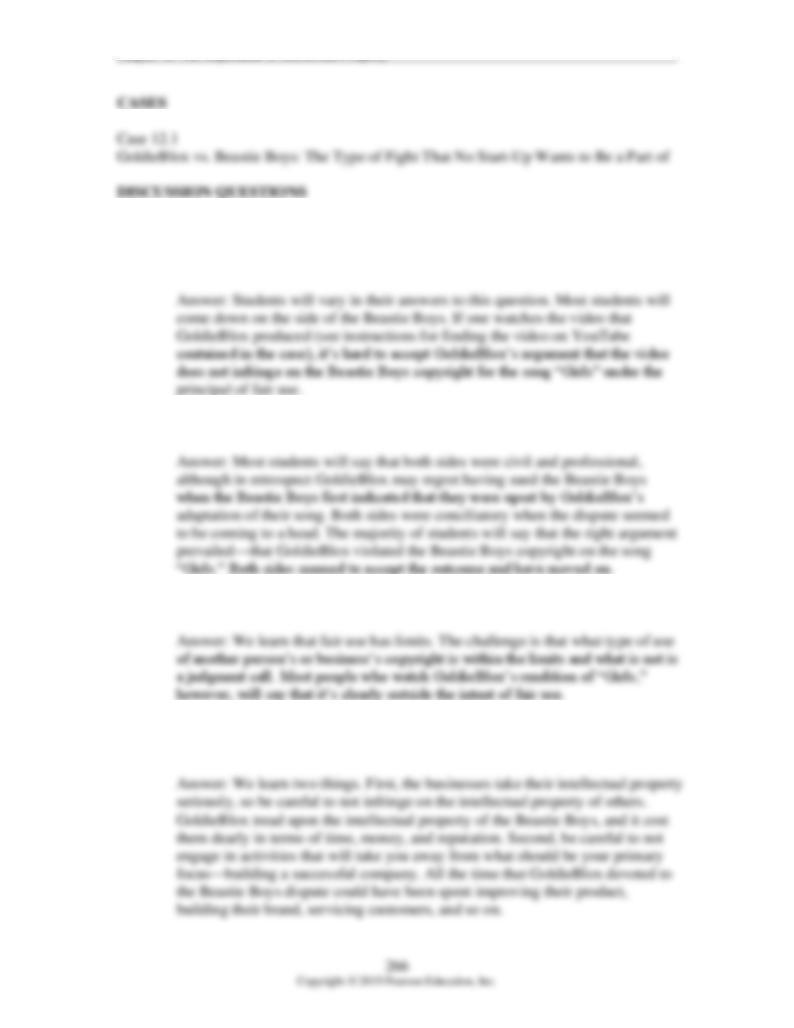
Chapter 12: The Importance of Intellectual Property
12-31.
If the case hadn’t been settled by GoldieBlox and the Beastie Boys and you had
been asked to render a judgment in the case, would you have rendered a
judgment in favor of GoldieBlox or the Beastie Boys? Explain your decision.
12-32.
Briefly comment on how both sides handled the dispute.
12-33.
What do we learn about fair use from the GoldieBlox–Beastie Boys dispute?
12-34.
What do we learn about the process of launching and growing a firm, in general,
from the GoldieBlox–Beastie Boys dispute?
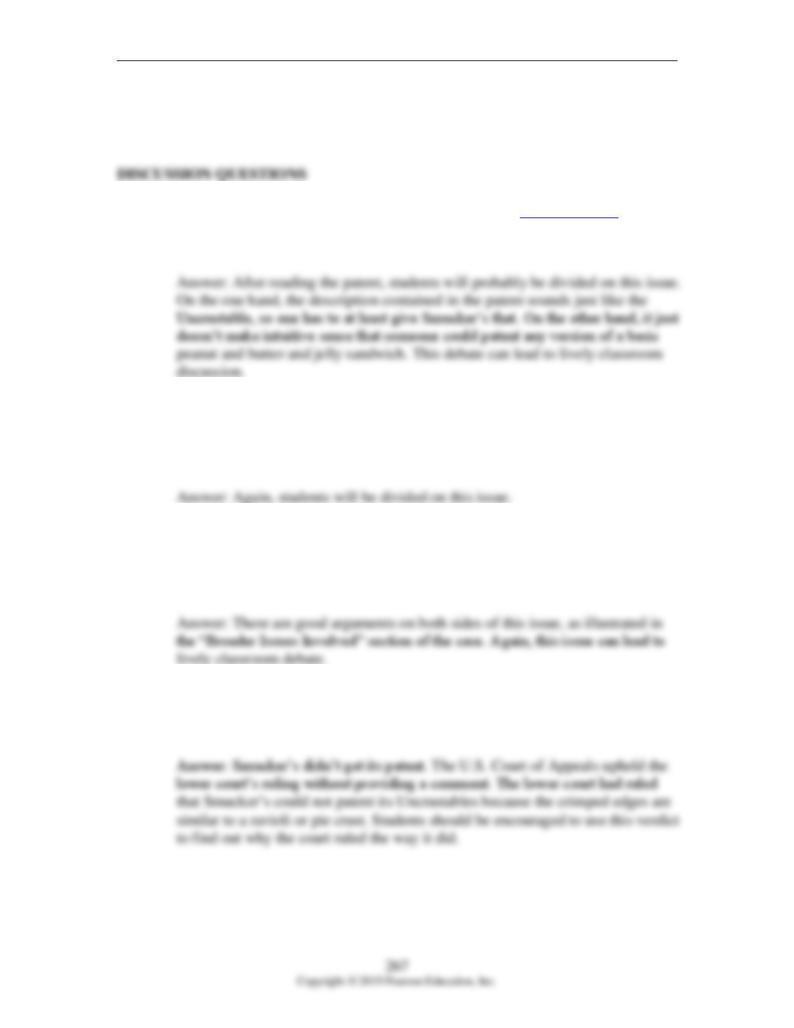
Chapter 12: The Importance of Intellectual Property
Case 12.2
You Make the Call: Can a Company Patent How It Makes a Peanut Butter and Jelly
Sandwich?
12-35.
Go to the U.S. Patent & Trademark Office’s Web site (www.uspto.gov) and look
up Patent No. 6,004,596. Read the patent. After reading the patent are you more
inclined or less inclined to side with the Smucker’s point of view?
12-36.
Type “Uncrustables” into the Google search engine and look at the Uncrustables
sandwich. Spend a little time reading about the Uncrustables on Smucker’s Web
site. Again, after looking over the Web site, are you more inclined or less
inclined to side with the Smucker’s point of view?
12-37.
In regard to the arguments espoused by the “critics” of the U.S. patent system
and the “advocates” of the U.S. patent system, with which of the points of view
do you agree? Thinking as an entrepreneur, use your own words to state why you
think the critics or the advocates have a stronger point of view.
12-38.
After using a search engine to discover how the court ruled, why do you think
the court ruled as it did? Use materials in the chapter to explain and justify your
thinking.